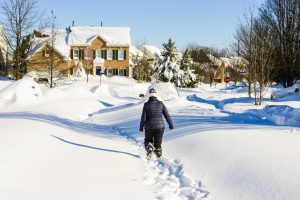Maybe it has taken longer than expected to find the perfect house, or perhaps you've always wanted to build. You find construction exciting and adore the idea of designing a home from the ground up. Surprisingly, an ideally situated plot just landed on the market, and it's priced to sell. Unfortunately, there's an issue.
Winter is approaching, and it doesn't intuitively feel like a good time for building or renovating. On the one hand, you're concerned about getting involved in a project challenged by cold weather conditions. On the other, you don't want to lose your auspicious real estate opportunity.
Variables unique to wintertime construction are worth consideration. Below we've compiled several things to consider to help you make well-informed decisions and implement effective project plans—even in freezing temperatures.
Sub-Freezing Temperatures
If the thermometer reads below 32 degrees Fahrenheit, any task that requires water is compromised. Mortar used in brickwork, for instance, will not bind properly. If a brick structure is in progress, freezing temperatures may cause cracks to form as water in connective mortar expands. This can significantly damage the structure's stability, resulting in the need to demolish and rebuild.
Rendering exterior walls, paving with asphalt and pouring cement are also problematic. It's vitally important to monitor both outdoor and ambient temperatures carefully, as well as future-forecasted probabilities. Delaying projects because of the weather can be costly, but perhaps not as much as having to redo them entirely if caution is not heeded.
Some contractors find a happy medium setting up heat lamps or arranging portable fuel heaters. These temporary measures work well, as long as potentially dangerous fumes are vented out, and site electrical wiring supports added wattage.
Other cold weather strategies include use of materials developed with year-round efficacy in mind. Precast concrete, for example, is cast and cured in a temperature-controlled factory setting. From there, materials are shipped straight to construction sites for installation. Concrete panels for walls, flooring, beams and planks are guaranteed for strength and durability, as well as fire resistance.
Extra Safety Considerations
Contractors who work in winter bundle up. Extra layers of clothing, bulky jackets and insulated gloves all lend distinct safety concern to any cold weather project. Not only does added padding slow laborers down, but it also increases the potential for accidental clashes with running equipment and valuable materials.
Snow and ice onsite present another challenge. Extra time to shovel out and sufficiently warm up machinery takes its toll on overall productivity, while great care must be exercised to avoid slip-and-fall injuries.
Projected time loss, however, should be reviewed in comparison to cost. Many bid contracts that reflect lower pricing to secure work during the slow winter months. If your deadline is not urgent, consider saving on labor-related fees. As long as site safety remains the focus, together with flexible completion requirements, it's a win-win.
Early Nightfall
Diminished daylight is an inevitable winter trademark. If proposed tasks take longer than expected—perhaps due to weather conditions or even the slow pace of bundled-up laborers—and require closure after nightfall, spot or floodlights may be needed.
Again, this is a question of potential added cost versus overall bid, as well as all-important electrical support.
Batten Down the Hatches
Early nightfall presents site-specific security risks. It is not uncommon for expensive machinery to be parked in the lot overnight. Metal scraps, hand tools and boxed appliances awaiting installation are easy enough to stow away in storage trailers, but large equipment and piles of heavy material remain outdoors, open to the possibility of criminal damage and theft.
Contractors can minimize such threat with a number of strategies including employment of overnight security guards, arranging for webcam surveillance and placing motion detector floodlights in strategic locations.
Move-In Ready
Consider broadening your definition of what constitutes move-in ready. If your preliminary home structure is up and passes inspection, you can move in. Put decorative touches such as exterior paint, fence installation, gateway erection and property landscape on hold for warmer months. By that time, after living in the house and familiarizing yourself with its flow, you may have a completely different vision altogether of how you'd like the outside to look.
Choosing to build in winter can be cost-efficient and advantageous as long as weather and safety-related issues are identified and addressed proactively. Go ahead—get that perfect piece of real estate. It'll make an unforgettable holiday project!








